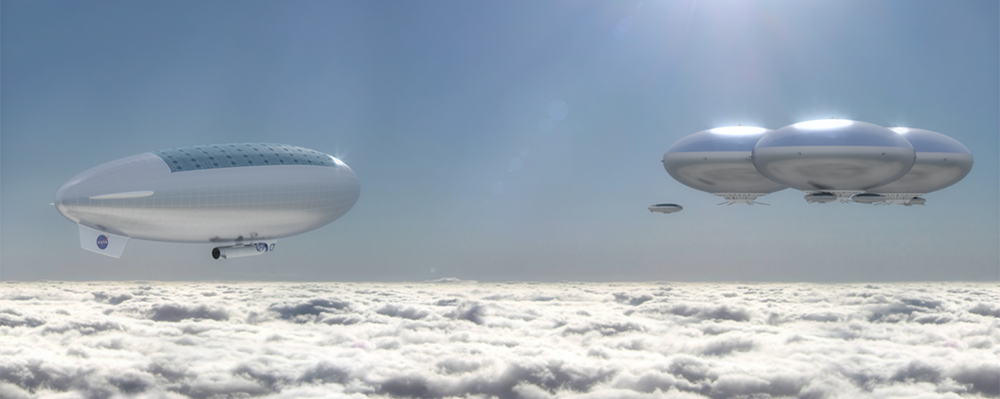What life on Venus would really look like

For more than a century, scientists and science fiction writers alike have dreamt about life on Venus. Once envisioned as a tropical swamp world, the first missions to Venus in the 1960s revealed that our planetary neighbor is actually a scorching hellscape. But early spacecraft missions also showed that 30 miles above the surface, conditions are more hospitable. After that, the dream of life on Venus moved to the clouds.
The truth about those clouds, however, may be stranger than fiction. If alien life is present up there, it probably isn’t carnivorous plants or electric blue space jellyfish. Instead, the skies of Venus might be home to microbial refugees that escaped the surface eons ago as the oceans boiled away, took up residence inside droplets of sulfuric acid, and have been kept aloft ever since by ripples in the atmosphere.
That, at least, is what a team of scientists proposes in a paper published recently in the journal Astrobiology. Starting with the now fifty-year-old hypothesis that Venus’ clouds might harbor life, the study attempts to answer a simple question: How would that actually work? Assuming Venus’ high-flying life forms don’t have airships, how would they stay put up there over millions to billions of years?
“No one really thought about that,” MIT astronomer and lead study author Sara Seager told The Science of Fiction. “How could life stay up there long enough? How could it reproduce fast enough?”
To answer those questions Seager and her colleagues started with a few assumptions. First, they assumed that any life on Venus is confined to a thin atmospheric layer some 30 to 37 miles up, where temperatures and pressures are comparable to those at Earth’s surface. Second, while there are free-floating microbes swirling about in Earth’s atmosphere, the scientists assumed that Venusian life forms can only survive inside liquid cloud droplets for a simple reason: The atmosphere itself is fifty times drier than the driest deserts on Earth.
“It’s drier than anything you could imagine,” Seager said.
The trouble with life inside a Venusian cloud droplet—aside from the fact that we’re talking about droplets of concentrated acid, more on that in a moment—is that droplets glom together over time, growing bigger and heavier. Eventually, cloud droplets become so heavy that they rain out. On Venus, that means falling from the temperate zone into a lower atmospheric oven, where the droplet quickly evaporates and any microbes inside it are burned to a crisp.
Unless those microbes go into suspended animation first.
When microbes on Earth are subject to harsh conditions, they often become spores—ultra-sturdy, dried-out husks of DNA and protein that reactivate when the environment becomes more hospitable. If Venus’ cloud microbes transform into spores as they rain out of the temperate zone, they might be able to survive the hotter atmosphere below. And because they would be shedding the weight of their liquid droplet on descent, they might not fall too far.
In fact, Seager and her colleagues think that the spores would settle into a layer of stagnant haze directly below Venus’ temperate cloud decks. Data from the Pioneer Venus probes in the 1970s showed that this haze layer contains particles similar in size to spores on Earth. Hibernating microbes, Seager said, “don’t make up the entire haze layer, but you can imagine them populating it.”

Eventually, these dormant bugs would be lofted back up into the clouds, where new droplets would condense around them, causing the microbes to re-activate and reproduce for several months before settling out again. The new paper proposes the microbes’ ascent would be driven by atmospheric gravity waves, ripples that form when air flows over mountains on both Earth and, scientists think, Venus. Seager says this is “the weakest part of the whole hypothesis” because gravity waves don’t move matter per se, although they can influence wind patterns.
Another big unknown is how Venus’ sky microbes would survive and reproduce in acid strong enough to dissolve terrestrial life forms in seconds. But while we can’t survive in a Venusian acid bath, it’s possible the local bugs have found a way to protect themselves from their harsh home, perhaps by secreting elemental sulfur shells or using acid-resistant materials like graphite for their DNA.
Seager and her colleagues’ proposal is “plausible and very clever,” said astrobiologist David Grinspoon, a long time proponent of the idea that life might exist in Venus’ clouds. Grinspoon says that while scientists have known about Venus’ stagnant haze layer for a long time, connecting it to a microbial life cycle is novel. “The idea of that sub-cloud haze as a possible repository of life in spore form that could serve as nuclei for new cloud particles—I think that’s brilliant,” he said.
While the theory is obviously speculative, Grinspoon says that in astrobiology it can be worth doing deep speculative dives because they can lead to testable predictions.
“That to me is the exciting thing,” he said. “It's motivating people to say, ok, what kind of mission should we send to possibly observe this in action?”
Interest in sending a dedicated probe to Venus—something NASA hasn’t done since 1989—seems to be growing these days, with the U.S. space agency selecting two potential Venus missions for further development in 2020. Calls to re-prioritize Earth’s noxious neighbor intensified last fall after a team of scientists, including Seager, announced they had detected the phosphine gas, a stinky, toxic molecule associated with microbial activity on Earth, in Venus’ atmospheric sweet spot. Other research teams have been unable to reproduce that detection, but it remains an active area of investigation. And if phosphine is present in the skies of Venus, we won’t be sure how it got there until we send a probe.

While scientists are developing new missions to Venus, recent insights into the planet’s potential biology should give science fiction writers plenty of new inspiration for stories. Those interested in writing scientifically grounded stories about life on Venus might think about how to incorporate Seager’s idea of a haze layer that acts as a biological seed bank, Grinspoon says. They could also explore an atmospheric biosphere that relies on chemicals from volcanic eruptions, given the emerging body of evidence that Venus may be volcanically active.
Grinspoon notes that in addition to the recent hubbub over phosphine, scientists have long puzzled over a UV-light absorbing substance in Venus’ clouds that might be connected to life, perhaps some sort of photosynthetic pigment.
“If you're a hard science fiction writer trying to write stuff that's speculative and exciting, you might have a field day with that because it permeates the atmosphere and we just don't know what it is,” Grinspoon said. “So you could you could write a story where that is some kind of living stuff, and nobody would be able to show you're wrong until we figure out what it is.”
Top image: NASA